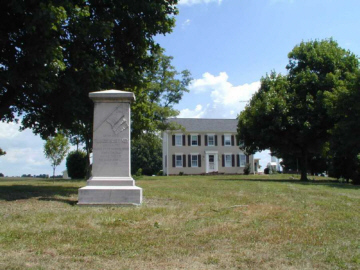Photo credit: Don Cook , 2002
Property Name: Terra Rubra
Date Listed: 7/24/1978
Inventory No.: CARR-2
Location: 1755, Keysville Bruceville Road, Keymar, Carroll County
Description: The present farmhouse at Terra Rubra is built on the site of the original house, which was the birthplace of Francis Scott Key, author of "The Star Spangled Banner." The original house was sold after Key's death and deteriorated until a storm in the late 1850s furthered its destruction. Shortly after this, it was torn down to provide for a new and more substantial house. A painting of the original house by Francis Scott Key's grandson, John Ross Key, depicts a 2 1/2-story structure with a four-bay-wide main facade and a colonnaded portico containing a second story porch across the full length of the façade. The chimneys are gable end, there are three gabled dormers on the roof, and the roofline extends across the front to form the portico roof. The brick farmhouse that replaced the earlier building is built on part of the latter's fieldstone foundation. It is a 2 1/2-story, five-by-two bay structure of stretcher bond with interior gable-end chimneys. The plan of the house is L-shaped with a parlor and dining room on either side of a central passageway which contains the staircase. The kitchen is in the ell. Some of the materials of the original house were used in the construction of the present structure. The main façade faces west and has a central doorway inset with molded panels on the wall sides and a frontispiece of half-columns with Corinthian capitals supporting the flat pediment. Above the six-paneled door is a four-light transom ornamented with a row of dentil molding. This frontispiece is probably a 20th century addition. The other four bays on the main floor and the five bays on the second floor contain 6/6 double hung sash windows with blinds and flat wood pediments with dentil trim. The dentil pattern is repeated on the roof cornice. The north gable end has a window identical to those on the main façade in the first floor bay towards the west. There are also two half-story windows here and in the south gable end. The south façade has the ell built flush to the wall of the main section. The main section's fenestration has two windows diagonally arranged--one on the first floor in the west bay and one on the second towards the east.. The ell of the south façade has a small porch with a shed roof on the main floor and two 6/6 sash windows on the second floor. The north façade of the ell originally had a double-tiered frame porch between the house proper and the first bay of the ell. This has since been bricked in. The rear of the main section of the house has a window on each floor opposite the ell and the ell rear façade has two half-story windows. Two stone outbuildings are said to be from the original estate. One was used as a slave quarters and is now connected to the house. The other was a smokehouse.
Significance: The original house at "Terra Rubra" was built in the 1770s when the land was part of Frederick County. The land patent was granted to Philip Key in 1753 and passed into the possession of his son Francis Key. Francis Key wanted to establish an estate at "Terra Rubra" for his son, John Ross Key, to operate and inherit. The mansion house was built and the farm was set up on a large scale, as was common at that time, with various outbuildings to provide for the self-sufficiency of the estate and slaves for the manual labor. After serving in the Revolutionary War, John Ross Key returned to "Terra Rubra" to pursue the life of a gentleman-farmer. His son, Francis Scott Key, was born at "Terra Rubra" on August 1, 1779. A painting of the original house by Francis Scott Key's grandson, John Ross Key, depicts a 2 1/2-story structure with a four bay wide main façade and a colonnaded portico containing a second story porch across the full length of the façade. The chimneys were gable end, and there were three gabled dormers on the roof, and the roofline extended across the front to form the portico roof. Key spent his early childhood on the estate and visited his family there during vacations and summers when he was a student in Annapolis. He became a lawyer, received his training in Frederick, Maryland, and settled in Georgetown, D.C. to establish his business. In 1814 he went to Baltimore in an effort to secure the release of Dr. Barnes, a prisoner of the British fleet in the Baltimore harbor. While Key was on board a British vessel, the British began an attack on Baltimore and detained Key. During this battle, Key wrote a poem to the tune of "Anacreon in Heaven" which later became the National Anthem.


